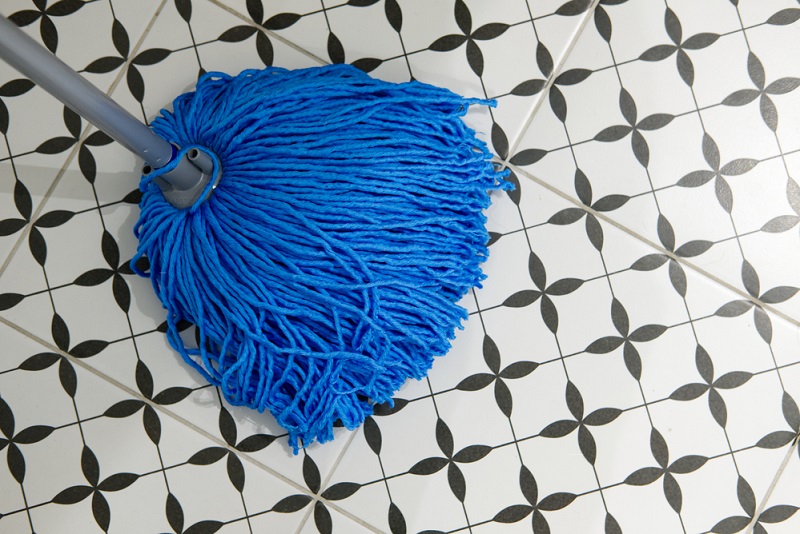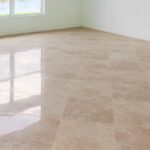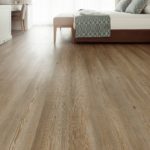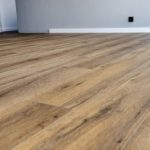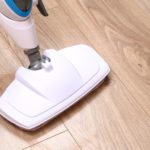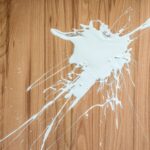Tiled floors, particularly porcelain and ceramic ones, can last a lifetime if they’re taken care of properly throughout their life! Not to mention that sleek, well-kept floors can enhance the appearance of a home.
But how do you keep tiled floors clean? And can all tiles be cleaned in the same way?
Find out how to clean tile flooring and more below!
The guide below has been split up by type of tile, so skip to the section that applies to you!
Tip: Test your chosen cleaning solution out before you use it. And if in doubt about how to wash a tiled surface, chat with the floor’s manufacturer – they’ll be able to give you additional advice!
How to Clean Ceramic, Vinyl, Porcelain and Linoleum Tiles
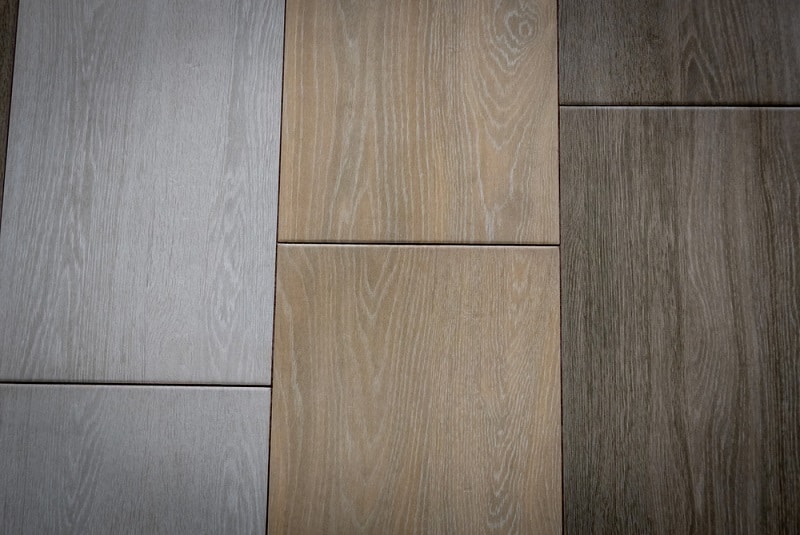
Step 1: Get the room ready
Just before you start cleaning, it’s worth having a micro-clean of the room, so you can pick up any rubbish on the floor, move any bowls of pet food out of the way, and stack the chairs onto the table, for example.
By doing this, you’ll expose a lot more of your floor, so you’ll be able to clean it better.
In addition, you should open windows in the room, so lots of fresh air can circulate the space.
This will come in handy later on when you need to dry the floor because the air will speed up the drying process for you.
Step 2: Remove dirt from the surface
Before you soak your floor, you’ll need to gather up all the dust and debris on it.
So, brush the entire tiled floor with a soft-bristled brush, or hoover it with the brush bar turned off so you don’t leave tiny scratches all over your floor.
At this point, you’ll be gathering up all the hair, chunks of food and crumbs that are scattered all over the surface.
Don’t forget to sweep and hoover in all the tight spots—you won’t believe how much aged debris gets into these spaces!
Tip: Sweep the floor daily to keep the dust and grime at bay.
Step 3: Get your soapy water ready
One of the easiest ways of cleaning a floor is to use washing-up liquid, a product that most of us have at home anyway!
In a bucket, mix a few drops of washing-up liquid with lukewarm water. You don’t need to add too much washing-up liquid—you don’t want to end up in a sudsy mess! Remember, less is best!
Tip: When it comes to removing tough stains, some people swear by using white vinegar and water to spot treat stains before cleaning a floor. And although this may be a great cleaner, you must use this mixture with caution when cleaning tiled surfaces, as it can often do more harm than good (especially to natural stone tiles). If you’re going to use vinegar, make sure you test it out on a discreet patch first and dilute it in water.
Step 4: Grab the right mop
For this job, you’ll need a microfibre mop. It’ll be able to get into all the nooks and crannies, go over textured tiles, and you can squeeze the moisture out of it with ease.
Tip: If you don’t want to use a mop and bucket, you can use a spray mop instead, but the results may not be exactly the same.
Step 5: Start mopping

With your damp mop at hand, start cleaning the tiled floor. It’s better if you start at the furthest end of the room and work back towards the door, so you don’t end up boxing yourself into the room!
Continuously soak your mop in the bucket and wring it out throughout this period, so the mop gets rinsed and cleaned out before it makes contact with another patch of floor!
The mop must not be saturated in soapy water when it makes contact with the tiled floor! And if there are pools of water visible, wring your mop out and gather up the excess water. Water makes tiles very slippery, so be careful.
Tip: Change your bucket of water frequently so you clean your tiles with fresh water not murky water!
Step 6: Rinse the floor
Rising the floor is incredibly important because this is when you’ll remove any leftover residue from the surface.
If the product residue isn’t removed from a tiled surface effectively, it’ll go sticky and filmyx and can make the surface slippery too.
To rinse a tiled surface, empty the dirty, soapy water out of the bucket and refill it with fresh lukewarm water. Next, rinse your mop under the tap to clean residue/grime off it.
Dip the mop in the fresh water, wring it out and start mopping the floor again. Remember to dip the mop in and out of the bucket of water throughout this time to rinse debris off it.
Step 7: Dry the floor
Grab a microfibre cloth and wipe the tiles so they end up dry and free from streaks and water stains.
If you don’t want to bend down to dry the entire floor, just pop the drying cloth on the end of an upside-down mop handle and push it around!
Leave the floor alone for a few minutes (allows the patches you might’ve missed to dry), and then replace your furniture and items.
Note: If your ceramic tiles are sealed (including the grout), you can steam clean them. Don’t steam clean vinyl and linoleum tiled floors.
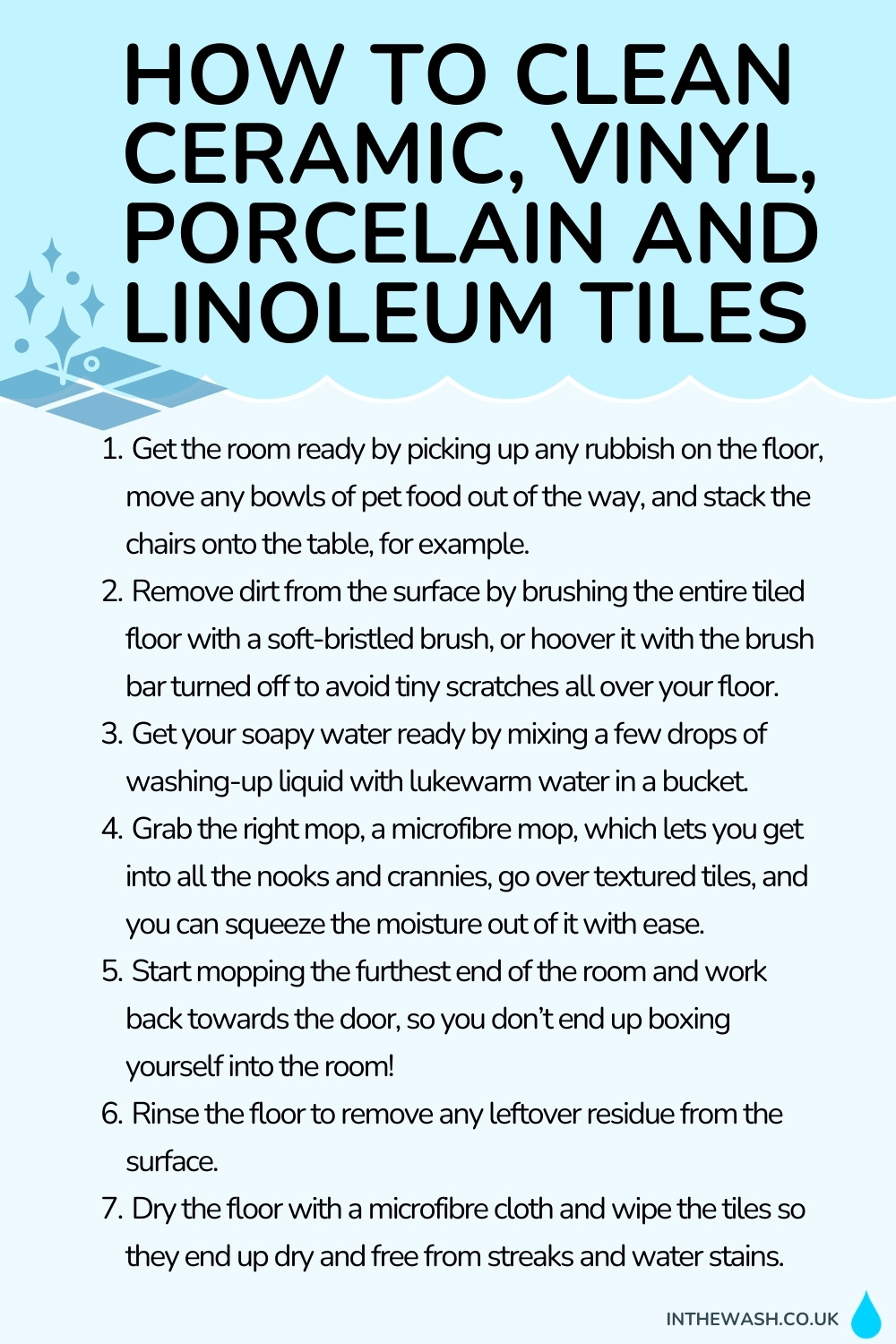
How to Clean Natural Stone Tiles

Use this method for marble, slate, limestone, terracotta and granite.
Natural tiles are an excellent addition to any home. But because they’re prone to scratching and are usually porous, you’ve got to take care of them a little more carefully!
You shouldn’t use too much water to clean these surfaces and you should avoid using hard tools to wash them.
It’s better if you stick to using soft tools and mild cleaners! And you should take your time carrying out the cleaning task.
Note: Don’t use acid-based cleaners on any type of natural stone. This includes vinegar and lemon juice.
Marble
Follow Steps 1 to 7 above to clean marble tiles. But make sure you use a very soft brush to sweep the floor, and only use a minimal amount of water to wash the surface (the mop must be wrung out).
After you’ve cleaned the surface, you should dry it with a cloth so you don’t get water stains on the marble.
Further to this, it’s worth re-sealing your marble tiles annually to protect them from wear and tear and general spillages throughout the year.
Slate, limestone and granite
These tiles can scratch very quickly, so only treat them with pH-neutral cleaners and with very, very soft tools. And as above, remember to dry your floor when you’re done cleaning it.
Also, you may need to seal these types of tile up as they’re also known for cracking with wear!
If you happen to stain one of these types of tile, you’ll need to purchase a specialised cleaner that is specific to your tile type to remove the blemish before it’s too late.
Terracotta
Gently brush the terracotta surface and wash it down with a neutral cleaner and very little water.
You should continuously mop the surface so it doesn’t get too wet, and you must not get water on the grout.
You should make a conscious effort to dry the tiles when you’re done cleaning them, which can be done with a dry, soft cloth.
In addition, you should apply a sealant to the tiles to protect them!
Note: Don’t use a steam mop on any of the tiled floors mentioned above.
Other Ways to Clean Tile Flooring
If the methods above don’t appeal to you, you have a couple of other options.
Specialised cleaners
You don’t really have to use chemical-heavy goodies to clean tiled floors. In most cases, a little drop of water and mild soap is ample. But if you’d like to buy an actual tile cleaner for the job, check out the options below:
- Beckmann Stone & Tile Floor Cleaner not only cleans tile and stone surfaces but breathes a new lease of life into them. This liquid formula can treat stains, doesn’t have an unpleasant smell and is easy to use.
- If you’re after a solution that can work in a spray mop or bucket and can also clean tiled floors, including granite, marble and ceramic, and laminate floor, look no further than Lakeland’s Stone and Tile Floor Cleaner. What’s even better is it dries quickly, and there’s no need to rinse the product off, which saves you time in the long term!
- Weiman Stone & Tile Cleaner has a pH-neutral formula and is derived from plant ingredients. It can be used on both tile and stone floors, as well as luxury vinyl. The product can be used straight out of the bottle and doesn’t need to be mixed in water to be used effectively.
- HG Tile Cleaner Extra Strong is part of HG’s mammoth range of cleaning products! This particular product is incredibly powerful and can break through old, toughened grime with ease. You might have to use a little elbow grease to work out certain stains, but the end result will be worth it!
Note: Make sure the specialised cleaner you decide to buy is suitable for your tiled floor.
Professional cleaner
It’s also possible to call someone in to clean your tiles for you if you don’t want to do it yourself.
This professional could be a cleaner who comes to clean your house every few days or a company that specialises in cleaning floors.
Either way, make sure you do plenty of research into the path you wish to go down. And always get a quote before someone starts doing the work for you.
How to Clean Tile Grout
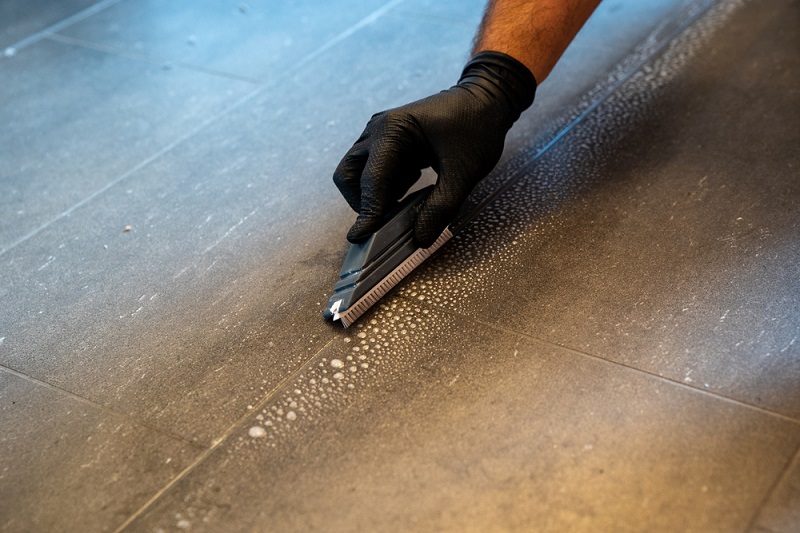
Grout tends to start looking a little grotty over time, especially when it’s exposed to all kinds of spillages and dirt!
An easy way to clean grout is to use bicarbonate of soda. In a shallow bowl, create a paste from bicarbonate of soda and water, and then spread this paste carefully over the filthy grout.
Leave the paste on the grout overnight, then the next day, brush the grout clean using a very soft toothbrush.
Sometimes, you can use an official grout cleaner, but this isn’t always the most suitable option. Grout cleaners can be packed with many different chemicals, and the chemicals in question can often affect tiles.
If you’re going to use such a product, make sure the cleaner can be used safely alongside the type of tiles you have! Otherwise, you’ll end up making a costly mistake and will ruin your tiles in the process!
How Often Should You Clean Tiles?
There isn’t an exact answer to this question because it all depends on your household’s habits and how busy your home is.
As a general rule, you should clean your tiled kitchen floor every fortnight, brush/hoover it every day, and mop up spills immediately. If you do this, your floor should be relatively clean. In contrast, you should clean your tiled bathroom floor every week.
However, you can increase how often you clean your tiles if you live in a busy home where there’s a lot of foot traffic!
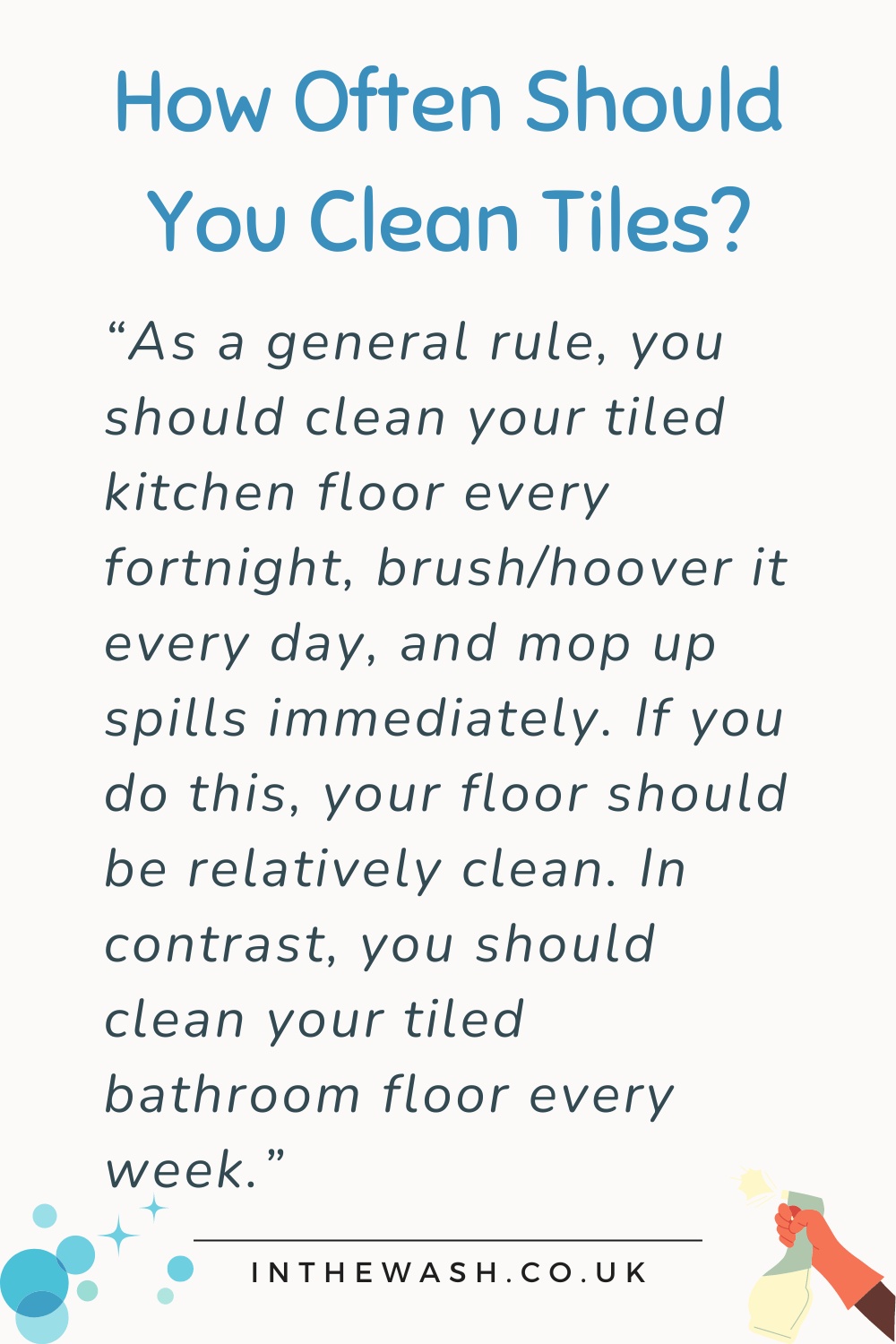
Why Do Tiles Sometimes Look Dirty After Cleaning?
The most straightforward explanations for this are:
- You didn’t rinse the mop enough as you cleaned the floor.
- You didn’t empty the dirty water out of the bucket and re-fill the bucket with fresh water during the cleaning process. Consequently, you kept reapplying the dirt onto the floor instead of cleaning it off.
- You didn’t rinse the cleaning solution off the floor effectively, so you’re now left with a dull, filmy coating all over the tiles that makes them look grotty.
How Do You Keep Tiles Clean In Between Cleans?
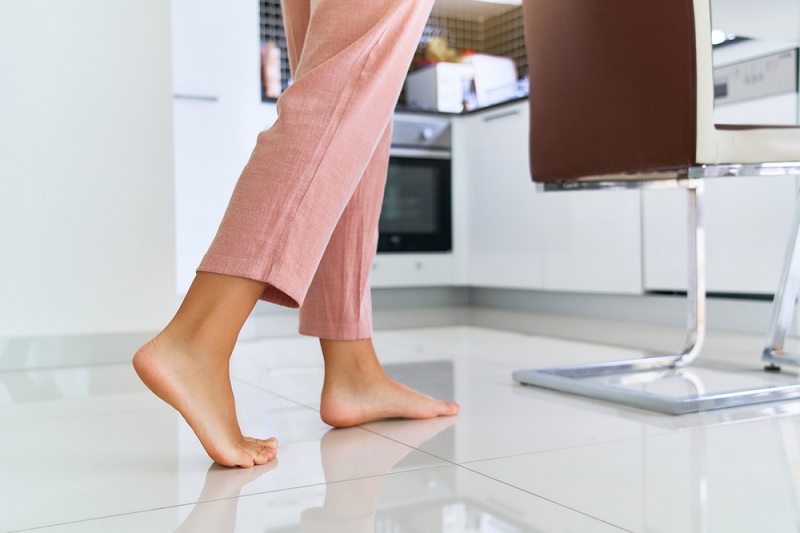
Here are a few ideas on how you can keep your floors clean in between washes:
- Ask people to take their shoes off before they enter.
- Make sure people wipe their feet before entering. You should also wipe your pet’s paws.
- Pop mats down to protect the surface.
- Mop up spillages and sweep up dirt as soon as possible.
- Don’t allow obvious grime to sit and fester on the tiled surface, get rid of it.

Bethan has a passion for exploring, reading, cooking and gardening! When she’s not creating culinary delights for her family, she’s concocting potions to keep her house clean!
